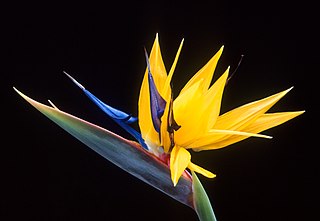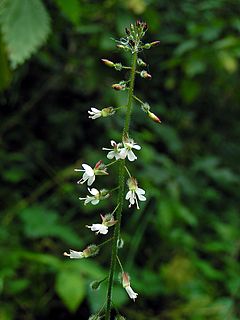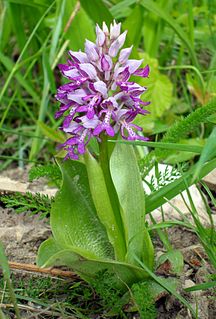
Royal Botanic Gardens, Kew is a non-departmental public body in the United Kingdom sponsored by the Department for Environment, Food and Rural Affairs. An internationally important botanical research and education institution, it employs 1,100 staff. Its board of trustees is chaired by Dame Amelia Fawcett.

Strelitzia is a genus of five species of perennial plants, native to South Africa. It belongs to the plant family Strelitziaceae. The genus is named after Queen Charlotte of the United Kingdom, who was born a princess of the house of Mecklenburg-Strelitz. A common name of the genus is bird of paradise flower/plant, because of a resemblance of its flowers to birds-of-paradise. In South Africa, it is commonly known as a crane flower and is featured on the reverse of the 50-cent coin. It is the floral emblem of the City of Los Angeles; two of the species, S. nicolai and S. reginae, are frequently grown as houseplants.

Knightia is a small genus of the family Proteaceae endemic to New Zealand, named in honor of Thomas Andrew Knight. One extant species, K. excelsa (rewarewa) is found in New Zealand. Two further Knightia species are found in New Caledonia, although they were placed in the genus Eucarpha by Lawrie Johnson and Barbara Briggs in their influential 1975 monograph "On the Proteaceae: the evolution and classification of a southern family", a placement supported in a 2006 classification of the Proteaceae. A fossil species from upper Miocene deposits in Kaikorai has been described as Knightia oblonga. Knightia has been placed in the tribe Roupaleae of the subfamily Grevilleoideae.

The Circaea, or enchanter's nightshades, are a genus of flowering plants in the evening primrose family Onagraceae. About two dozen taxa have been described, including eight species. Plants of the genus occur throughout the temperate and boreal forests of the Northern Hemisphere. Three taxa occur in North America: Circaea alpina, Circaea canadensis, and the hybrid Circaea × sterilis. The generic name Circaea refers to the enchantress Circe from Greek mythology who is said to have used the herb as a charm.

Selenicereus, sometimes known as moonlight cactus, is a genus of epiphytic, lithophytic, and terrestrial cacti, found in Mexico, Central America, the Caribbean and northern South America. The term night-blooming cereus is also sometimes used, but this is also used for many night-blooming cacti, including Epiphyllum and Peniocereus. In 2017, the genus Hylocereus was brought into synonymy with Selenicereus. A number of species of Selenicereus produce fruit that is eaten. The fruit, known as pitaya or pitahaya in Spanish or as dragon fruit, may be collected from the wild or the plants may be cultivated.

Pereskiopsis is a genus of cactus in the subfamily Opuntioideae. Unlike typical cacti, it has persistent fleshy leaves. The genus name refers to its resemblance to the genus Pereskia. Most species are found in Mexico south through Guatemala to Honduras, with one species in Bolivia. The incorrect spelling Peireskiopsis has also been used.

Orchis militaris, the military orchid, is a species of orchid native to Europe. It is the type species of the genus Orchis.

Habenaria, commonly called rein orchids or bog orchids, is a widely distributed genus of orchids in the tribe Orchideae. About 880 species of Habenaria have been formally described. They are native to every continent except Antarctica, growing in both tropical and subtropical zones.
Charles Baron Clarke was a British botanist. He was born at Andover, the eldest son of Turner Poulter Clarke. He was educated at King's College School, London, and at Trinity and Queens' Colleges, Cambridge. He began the study of law at Lincoln's Inn in 1856 and was called to the bar in 1860. He lectured in mathematics at Presidency College, Calcutta, from 1857 to 1865. Clarke was Inspector of Schools in Eastern Bengal and later of India, and superintendent of the Calcutta Botanical Garden from 1869 to 1871. He retired from the Indian Civil Service in 1887. He was president of the Linnean Society from 1894 to 1896, and was elected a fellow of the Royal Society in 1882. He worked at Royal Botanic Gardens Kew until his death in 1906.

Hylotelephium is a genus of flowering plants in the stonecrop family Crassulaceae. It includes about 33 species distributed in Asia, Europe, and North America.

Kerriodoxa elegans, the white backed palm, is the only species of palm tree in the genus Kerriodoxa, in the family Arecaceae.
Townsonia, commonly called myrtle beech orchids is a genus of two species of flowering plants from the orchid family, Orchidaceae. They form small clusters of plants with their tubers connected, each tuber with one or two leaves. The flowers are inconspicuous.

Euphronia is a genus of three species of shrubs native to northern South America and is the only genus in the family Euphroniaceae. It was previously classified in the Vochysiaceae family and elsewhere due to its unique floral features, but the APG III system of 2009 recognized Euphroniaceae as distinct and placed Euphronia in it. Based on molecular data from the rbcL gene, it is sister to the Chrysobalanaceae.
Castilleja beldingii is a species of hemiparasitic plant in the broomrape family, formerly the only species in the genus Clevelandia, it was moved to the genus Castilleja, the 'indian paintbrushes', in 2009.

Nicandra is a genus of flowering plant in the family Solanaceae, native to western South America. It was first described by Michel Adanson in 1763. The genus is named for Greek poet Nicander of Colophon, who wrote about plants – notably in his poem Alexipharmaca, which treats of poisons and their antidotes.

Linnaea chinensis, synonyms Abelia chinensis and Abelia rupestris, commonly known as Chinese Abelia, is a semi-evergreen, densely branched shrub with dark green foliage. It is a species of flowering plant in the honeysuckle family Caprifoliaceae.
Dimetra is a plant genus in the family Oleaceae. It contains the single species Dimetra craibiana, native to Thailand and Laos. The genus and species were described in 1938 by the Irish botanist Arthur Francis George Kerr.
Vanzijlia is a genus of flowering plants belonging to the family Aizoaceae. It only contains one known species, Vanzijlia annulata.

Victoria boliviana is a species of water lily within the genus Victoria in the family Nymphaeaceae. It is the newest described species of the genus and its largest member in size and was officially identified in 2022.
Rosa abietina is a species of rose that was described by Jean Charles Marie Grenier. Rosa abietina is part of the genus Rosa, and the family Rosaceae.













